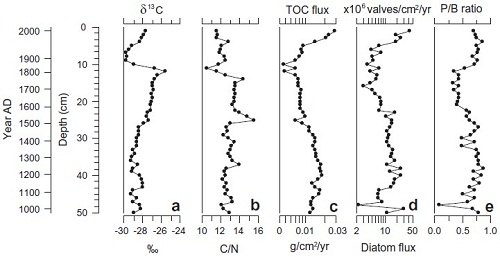The influence of the ratio of planktonic to benthic diatoms on lacustrine organic matter δ13C from Erlongwan maar LakeUpdate time:01 28, 2013
Vice Professor WANG Luo and his team report δ13C values for sediments from Erlongwan maar lake in northeast China. In this record, changes in δ13C cannot be explained by simple changes in aquatic productivity. Instead, values were likely influenced by differences in the ratio between planktonic and benthic algae, as indicated by the remains of diatoms. They discuss the possible reason is that the variation of δ13Corg in algae from different habitats is controlled by the thickness of the diffusive boundary layer, which is dependent on the turbulence of the water. Compared with benthic algae, which grow in relatively still water, pelagic algae are exposed to greater water movement. They also discuss how turbulence may play an important role in controlling carbon isotope fractionation in different diatom habitats.
Fig. 1 Stratigraphic profile of organic geochemical variables. (Image by WANG) Wang et al. The influence of the ratio of planktonic to benthic diatoms on lacustrine organic matter δ13C from Erlongwan maar Lake, Northeast China. Organic Geochemistry, 2013, 54: 62-68 (Download Here)
|
Contact
Related Articles
Reference
|
-
SIMSSecondary Ion Mass Spectrometer Laboratory
-
MC-ICPMSMultiple-collector ICPMS Laboratory
-
EM & TEMElectron Microprobe and Transmission Electron Microscope Laboratory
-
SISolid Isotope Laboratory
-
StIStable Isotope Laboratory
-
RMPARock-Mineral Preparation and Analysis
-
AAH40Ar/39Ar & (U-Th)/He Laboratory
-
EMLElectron Microscopy Laboratory
-
USCLUranium Series Chronology Laboratory
-
SASeismic Array Laboratory
-
SEELaboratory of Space Environment Exploration Laboratory
-
PGPaleomagnetism and Geochronology Laboratory
-
BioMNSFrance-China Bio-mineralization and Nano-structure Laboratory

 Print
Print Close
Close
